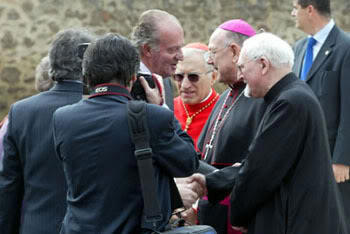
Juan Carlos (King of
Spain )
Royals
Is Prince William really the son of King Juan Carlos of Spain?
[2012] King of Spain 'is serial womaniser who
made a pass at Princess Diana'

Shaking hands with the Black Pope, Peter Hans
Kolvenbach.
JUAN CARLOS DE BORBON Y BORBON was born on January 5th, 1938 in
Rome, where the Royal Family was living at that time, having had to leave Spain
when the Republic was proclaimed in 1931. His father, Don Juan de Borbon y
Battenberg, Count of Barcelona and Head of the Spanish Royal Household ever
since King Alfonso XIII had relinquished this status, and his mother, Dona Maria
de las Mercedes de Borbon y Orleans.
At the express wish of his father,
he was educated in Spain, which he visited for the first time at the age of ten.
In 1954 he completed his Baccalaureate at the San Isidro School in Madrid, and
in 1955 began his studies at the Academies and Military Colleges of the Army,
the Navy and the Air Force. During this time he carried out his practice voyage
as a midshipman on the training ship Juan Sebastian Elcano and qualified as a
military pilot. In 1960.61 he completed his education at Madrid's Complutense
University, where he studied constitutional and international law, economics and
taxation.
Colegio Imperial de Madrid (also known as the Colegio Imperial
de la Compañía de Jesús or El Colegio de San Pedro y San Pablo de la Compañía de
Jesús en la Corte) was the name of a Jesuit teaching institution in Madrid.
Founded at the end of the sixteenth
century and reached its peak in the seventeenth century, acquiring the title of
"Imperial College" thanks to the patronage of the Empress Maria, daughter of
Charles V, Holy Roman Emperor and the wife of Maximilian II, Holy Roman Emperor.
Philip IV of Spain is considered the founder of the Reales Estudios in 1625.
Subjects included theology, philosophy, geography, and the sciences. Lope de
Vega, Francisco de Quevedo and Pedro Calderón de la Barca can be counted amongst
the institution's pupils. The institution's library served as the most important
one in Madrid until the 18th century, large part of which is now shared by the
Universidad Complutense y la Real Academia de la Historia.
When the Society of Jesus was
suppressed in 1767, Charles III of Spain re-established the university as the
Reales Estudios de San Isidro in 1770, as a continuation of the studies there.
The Jesuits returned from 1816-1820; 1823-1834. Between 1835 and 1845, it became
once again a lay institution, with the name of Estudios Nacionales,
incorporating with the Universidad Literaria de Madrid.
http://en.wikipedia.org/wiki/Colegio_Imperial_de_Madrid
Next door, the Instituto de San Isidro once went by the name of Colegio Imperial and, from the 16th century on, was where many of the country's leading figures were schooled by the Jesuits. http://www.lonelyplanet.com/worldguide/destinations/europe/spain/madrid?v=print